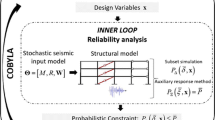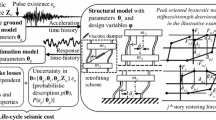Abstract
An optimization method for the consistent evaluation of two Rayleigh damping coefficients is proposed. By minimizing an objective function such as an error term of the peak displacement of a structure, the two coefficients can be determined with response spectral analysis. The optimization method degenerates into the conventional method used in current practices when only two modes of vibration are included in the objective function. Therefore, the proposed method with all significant modes included for simplicity in practical applications results in suboptimal damping coefficients. The effects of both spatial distribution and frequency content of excitations as well as structural dynamic characteristics on the evaluation of Rayleigh damping coefficients were investigated with a five-story building structure. Two application examples with a 62-story high-rise building and a 840 m long cable-stayed bridge under ten earthquake excitations demonstrated the accuracy and effectiveness of the proposed method to account for all of the above effects.
Similar content being viewed by others
References
Ambrosini RD (2006), “Material Damping vs. Radiation Damping in Soil-structure Interaction Analysis,” Computers and Geotechnics, 33(2): 86–92.
Berthelot JM, Assarar M, Sefrani Y and Mahi AE (2008), “Damping Analysis of Composite Materials and Structures,” Composite Structures, 85(3): 189–204.
Bilbao A, Aviles R, Agirrebeitia J and Ajuria D (2006), “Proportional Damping Approximation for Structures with Added Viscoelastic Dampers,” Finite Elements in Analysis and Design, 42(6): 492–502.
Chen W and Deng X (2005), “Structural Damping Caused by Micro-slip along Frictional Interfaces,” International Journal of Mechanical Sciences, 47(8): 1191–1211.
Chopra AK (1995), Dynamics of Structures: Theory and Applications to Earthquake Engineering, Englewood Cliffs, Prentice-Hall, New Jersey.
Clough RW and Penzien J (1995), Dynamics of Structures, McGraw-Hill, New York.
Housner GW, Bergman LA, Caughey TK, Chassiakos AG, Claus RO, Masri SF, Skelton RE, Soong TT, Spencer BF and Yao JTP (1997), “Structural Control: Past, Present, and Future,” Journal of Engineering Mechanics, ASCE, 123(9): 897–971.
Jeary AP (1997), “Damping in Structures”, Journal of Wind Engineering and Industrial Aerodynamics, 72: 345–355.
Kareem A and Gurley K (1996), “Damping in Structures: Its Evaluation and Treatment of Uncertainty”, Journal of Wind Engineering and Industrial Aerodynamics, 59(2–3): 131–157.
Klamo JT, Leonard A and Roshko A (2006), “The Effects of Damping on the Amplitude and Frequency Response of a Freely Vibrating Cylinder in Cross-flow,” Journal of Fluids and Structures, 22(6–7): 845–856.
Kumar N and Singh SP (2010), “Experimental Study on Vibration and Damping of Curved Panel Treated with Constrained Viscoelastic Layer,” Composite Structures, 92(2): 233–243.
Lee SH, Min KW, Hwang JS and Kim J (2004), “Evaluation of Equivalent Damping Ratio of a Structure with Added Dampers,” Engineering Structures, 26(3): 335–346.
Nashif AD, Jones DIG and Henderson JP (1985), Vibration Damping, John Wiley & Son, New York.
Occhiuzzi A (2009), “Additional Viscous Dampers for Civil Structures: Analysis of Design Methods Based on Effective Evaluation of Modal Damping Ratios,” Engineering Structures, 31(5): 1093–1101.
Papageorgiou AV and Gantes CJ (2010), “Equivalent Modal Damping Ratios for Concrete-steel Mixed Structures,” Computers and Structures, 88(19–20): 1124–1136.
Remillat C (2007), “Damping Mechanism of Polymers Filled with Elastic Particles,” Mechanics of Materials, 39(6): 525–537.
Xu J (2004), “A Synthesis Formulation of Explicit Damping Matrix for Non-classically Damped Systems,” Nuclear Engineering and Design, 227(2): 125–132.
Author information
Authors and Affiliations
Corresponding author
Additional information
Supported by: National Natural Science Foundation of China under Grant No. 51078032, the Visiting Scholar Foundation of China Scholarship Council, and the Center for Infrastructure Engineering Studies at Missouri University of Science and Technology
Rights and permissions
About this article
Cite this article
Pan, D., Chen, G. & Wang, Z. Suboptimal Rayleigh damping coefficients in seismic analysis of viscously-damped structures. Earthq. Eng. Eng. Vib. 13, 653–670 (2014). https://doi.org/10.1007/s11803-014-0270-9
Received:
Accepted:
Published:
Issue Date:
DOI: https://doi.org/10.1007/s11803-014-0270-9




